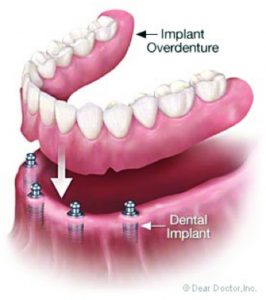By Dr. Ricardo S. Bocanegra, DDS
Dental Implants


Single Tooth Replacement: Immediately (at the same time an implant is placed) or after a period of healing, an abutment is attached to the implant. This is a device that “abuts” or joins the implant to a tooth form called a crown, which replaces the tooth part you see in the mouth. It will hold a custom-made crown that the dental laboratory will fabricate and match to your existing teeth. The custom crown is cemented or screwed onto the abutment to permanently keep it in place. Once the crown is in place, it should be indistinguishable from your natural teeth.
Mixed Multiple Tooth Replacement: As with single tooth replacement, temporary healing caps or abutments may be placed on multiple implants until the healing phase is complete. After healing, permanent abutments are attached to the implants. They can attach to custom-made crowns or bridgework that a dental laboratory will fabricate to match your existing teeth. In the final step, the custom bridge, which will replace multiple teeth, is cemented or screwed onto the abutments. The teeth have been replaced without disturbing the healthy teeth next to them, and bone loss has been halted.
Removable Implant-Supported Tooth Replacement:
If all of your lower teeth are missing, depending on the design of the removable restoration, two to six implants may be used to support a lower denture. If all of your upper teeth are missing, a minimum of four implants may be used to support an upper denture. Removable dentures are often used to replace extensive tooth, bone and gum-tissue loss, thus providing support for the facial skeleton, lip and cheeks. A new denture can have attachments that snap or clip it into place on the implants or a custom made, milled bar can be fabricated to create additional strength and support for the restoration. Design variations are often related to your bone density and number of implants present; your dentist will discuss these options during your consultation. A significant advantage of a removable denture is facilitating the cleaning of the dental implants.
How do implant tooth replacements differ from teeth?
Natural teeth and dental implants may look the same, feel the same, and even function in a similar way, but they are very different. The most important differences are in the way they attach to the surrounding bone, their response to dental disease, their maintenance, and repair.
Teeth attach to the surrounding bone by a periodontal ligament (“peri” – around; “dont” – tooth) made up of collagen fibers that join into the tooth on one side and bone on the other. Dental implants fuse directly to the bone.
The gum tissues also attach to the root of a tooth with collagen fibers as described above. However, gum tissues can only stick to the surface of dental implants.
Teeth are susceptible to dental decay as well as the need for root canal therapy; dental implants are metal and do not decay or need root canal. Teeth may also be susceptible to periodontal (gum) disease, while dental implants may be susceptible to peri-implantitis, an inflammatory response to bacterial biofilm of the tissues surrounding the implant, which can result in disintegration of the bone to the implant.
What type of maintenance do dental
implants require?
Implant crowns and other prosthetic (false) tooth replacements are made to be remarkably failsafe systems. They are removable and replaceable (only by your dentist), so that if damage or wear necessitates replacement, this can be accomplished without affecting the implant(s) or attachment to the bone.
Nevertheless, implants do require maintenance. It is important to practice good daily oral hygiene, including brushing and flossing to control bacterial biofilm. It is also important to see your dentist and dental hygienist. Special instruments are necessary to clean dental implants that will not damage their metal surface beneath the gum tissues. Your dentist will need to monitor your implants to make sure the integrity of the osseointegration is stable, and that the implant crowns, bridgework or dentures are functioning adequately.
Dr. Bocanegra is an accredited Fellow of the International Congress of Oral Implantologists, which required extensive training and testing of his expertise in a field that is continuing providing new and improved techniques to the benefit of patients seeking alternatives to permanent tooth replacement. He is competent, trained, and vastly experienced to not only place your dental implants, and /or remove unwanted teeth, but he will also custom design your teeth, smile, and chewing ability with the new replacement teeth whether they be part of a denture, bridge, or single tooth. Dr. Bocanegra also completed his Implant training at the University of Florida where he received much of his training. He is a member of the American Dental Association, The Florida Dental Association and the West Coast and Lee County Dental Associations.
Selecting a dentist is an important and personal decision. Our caring team will work hard to gain your confidence and trust. Want a professional review of your options? Call us at 239-482-8806 to schedule an appointment and visit our website at www.portofinodental.org for more information.
 Southwest Florida's Health and Wellness Magazine Health and Wellness Articles
Southwest Florida's Health and Wellness Magazine Health and Wellness Articles

